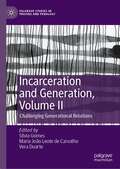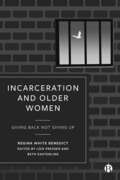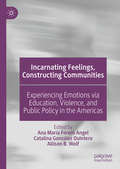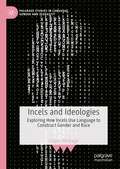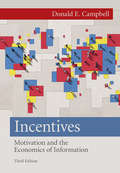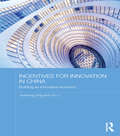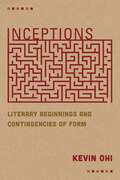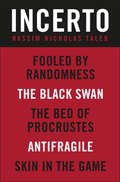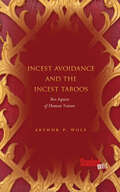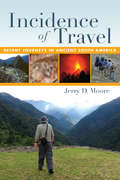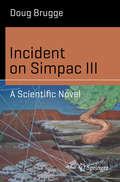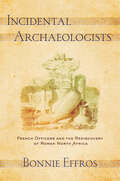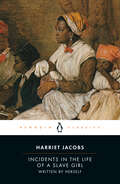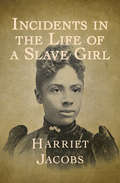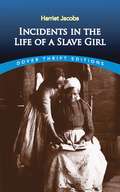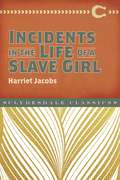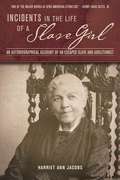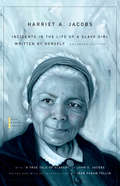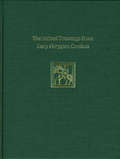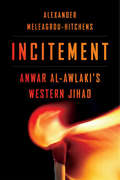- Table View
- List View
Incarceration and Generation, Volume I: Multiple Faces of Confinement (Palgrave Studies in Prisons and Penology)
by Sílvia Gomes Vera Duarte Maria João Leote de CarvalhoThis two-volume, edited collection lays the groundwork for an international exploration of incarceration and generation. Volume I explores an array of experiences, dynamics, cultures, interventions and impacts (in its different forms) of incarceration in specific generations: childhood, youth and emerging adulthood, adulthood and older age. It covers topics such as: the expansion of the penal landscape; the abolition of measures involving deprivation of liberty regarding children, the problem of unaccompanied migrant children; the incarceration of young adults and adults, exploring its impacts within and beyond incarceration; and the consequences of imprisoning older populations. Volume II examines intergenerational relations issues within different contexts of incarceration. Both volumes cover a range of geographic, judicial, and administrative contexts of incarceration from contributors across a range of subjects. This collection discusses public policies and the role of the state and the citizen, in particular when a citizen is deprived of liberty. It speaks to academics in criminology, sociology, psychology, and law, and to practitioners and policymakers interested in incarceration.
Incarceration and Generation, Volume II: Challenging Generational Relations (Palgrave Studies in Prisons and Penology)
by Vera Duarte Maria João Leote de Carvalho Silvia GomesThis two-volume, edited collection lays the groundwork for an international exploration of incarceration and generation, covering a range of geographic, judicial and administrative contexts of incarceration from contributors across a range of subjects. Volume II examines intergenerational relations issues within contexts of incarceration. It focuses on the intergenerational continuities in imprisonment; intergenerational justice and citizenship; the impacts of incarceration on multiple generations and within families; and media representations of the intergenerationality of incarceration. Volume I explores an array of experiences, dynamics, cultures, interventions, and impacts of incarceration in different generations. This collection speaks to academics in criminology, sociology, psychology, and law, and to practitioners and policymakers interested in incarceration.
Incarceration and Older Women: Giving Back Not Giving Up
by Regina White BenedictGenerativity or ‘giving back’ is regarded as a common life stage, occurring for many around middle age. For the first time, this book offers qualitative research on the lives and social relationships of older imprisoned women. In-depth interviews with 29 female prisoners in the south-eastern United States show that older women both engage in generative behaviours in prison and also wish to do so upon their release. As prisoners continue to age, the US finds itself at a crossroads on prison reform, with potential decarceration beginning with older prisoners. The COVID-19 pandemic has led many to consider how to thrive under difficult circumstances and in stressing the resilience of older incarcerated women, this book envisions what this could look like.
Incarceration and Regime Change: European Prisons during and after the Second World War
by Christian G. De Vito Ralf Futselaar Helen GreversPolitical instability is nearly always accompanied by fuller prisons, and this was particularly true during the "long" Second World War, when military mobilization, social disorder, wrenching political changes, and shifting national boundaries swelled the ranks of the imprisoned and broadened the carceral reach of the state. This volume brings together theoretically sophisticated, empirically rich studies of key transitional moments that transformed the scope and nature of European prisons during and after the war. It depicts the complex interactions of both penal and administrative institutions with the men and women who experienced internment, imprisonment, and detention at a time when these categories were in perpetual flux.
Incarnating Feelings, Constructing Communities: Experiencing Emotions via Education, Violence, and Public Policy in the Americas
by Ana María Forero Angel Catalina González Quintero Allison B. WolfAttempting to connect the academic discussion around the anthropology and philosophy of the emotions to real-life, everyday experiences, this collection brings together concrete cases and situations arising from specific social and political contexts throughout the Americas. In particular, the authors explore how emotions are generated, constructed, discovered, manipulated, and experienced throughout the Americas by exploring undertheorized topics ranging from investigating the emotional lives of prisoners in Colombia and Brazil who have committed “crimes of passion,” to Colombian soldiers’ experiences of core “emotional events,” to the role of emotions in immigration policy in the United States, to how emotions affect educators’ abilities to teach certain material. Taken as a whole, this innovative, interdisciplinary, collection of original essays is not merely comparative, but rather seeks to bring voices and methodologies from North and South America into conversation to generate innovative analyses and ways to reflect about emotions in response to violence, state policies, and educational systems.
Incarnating Grace: A Theology of Healing from Sexual Trauma
by Julia FederWINNER, COLLEGE THEOLOGY SOCIETY BOOK AWARDPrioritizes survivors of abuse by reexamining Christian ideals about suffering and salvation More than half of women and almost one in three of men in the United States have experienced sexual violence at some time in their lives. Yet our Christian tradition has failed survivors of sexual violence, who have been taught to believe that traumatic suffering brings us closer to God. Incarnating Grace attempts to save our broken ways of talking about God’s grace by unearthing liberating resources buried in the Christian tradition.Christian ideas about salvation have historically contributed to sexual violence in our communities by reinforcing the idea that suffering is salvific. But a God worth worshiping does not want human beings to suffer. Drawing on the sixteenth-century Spanish mystic Teresa of Avila as well as contemporary political and feminist theologians, philosophers, and legal scholars, author and Associate Professor of theology Julia Feder offers an account of Christian salvation as mystical-political.Feder begins by describing the breadth of traumatic wounding and the shape of traumatic recovery, as articulated by psychologists. Since the fullness of post-traumatic healing requires reserves deeper than those which can be articulated by the secular field of psychology alone, the book then introduces the Spanish Carmelite Saint Teresa of Avila and her theological insights, which are most helpful for constructing a post-traumatic theology of healing. Arguing that God stands against violence and suffering, the book also examines the notion of “senseless suffering,” a technical term that comes from Edward Schillebeeckx, a Catholic twentieth-century Flemish priest and theologian. The suffering of sexual violence serves no higher purpose or greater human value and pushes against all ways of making sense of the world as good and orderly. In the following chapters, Feder turns to two Christian virtues that animate post-traumatic recovery, courage and hope, and explores how Christian hope can provide a language to empower courageous activity undertaken toward healing.Incarnating Grace opens a new dialogue about salvation and violence that does not allow evil to have the last word.
Incels and Ideologies: Exploring How Incels Use Language to Construct Gender and Race (Palgrave Studies in Language, Gender and Sexuality)
by Frazer HeritageThis book explores how incels use language and other semiotic resources to construct ideologies of gender and race/ethnicity. The author theorises and positions incels' performances of masculinity against a backdrop of broader social sciences and linguistic literature, and discusses some of the limitations of different lenses through which incels have previously been understood, as well some of the ethical issues involved with researching a hostile community. Corpus linguistic methods and netnographic reflections are used to explore how incels construct ideologies about gender, gendered social actors, and race/ethnicity, as well as where these concepts intersect. Taking a post-structuralist critical analysis to this community reveals a number of way ideologies towards different groups based on social identities are linguistically constructed. This book will be relevant to those researching or studying language, gender, and sexuality, sociology, and criminology. Outside of academic applications, it is also written in a way that is accessible to external organisations interested in equality and the prevention of incel-ideology-motivated offline attacks.
Incense Magick: Create Inspiring Aromatic Experiences for Your Craft
by Carl F. NealImmerse yourself in the enchanting, sensory-rich world of incense and deepen your knowledge of a treasured and indispensable tool for your magickal life. Carl F. Neal, author of the popular book, Incense, offers this meticulously researched, globespanning guide to the magickal applications of incense.From "redecorating" a room with the perfect scent to performing intricate incense ceremonies, you'll learn to create aromatic enchantments using pellets, seals, powders, and other incense forms in meditations, rituals, spells, and even games.Take your practice to a deeper level as you discover burning techniques and mystical uses, both traditional and innovative.Rituals specific to different types of incenseGuidance for selecting incense and charcoalAn alphabetized list of traditional and modern incense ingredients, including rare botanicalsCombustible: smudging, sticks (masala and joss), cones, cylinders, and dhoopsNon-combustible: pellets (moist), loose incense, and powdersIncense seals, trails, and chainsCorrespondences for the elements, seasons, particular intentions, and more
Incentives (3rd Edition): Motivation and the Economics of Information
by Donald E. CampbellWhen incentives work well, individuals prosper. When incentives are poor, the pursuit of self-interest is self-defeating. This book is wholly devoted to the topical subject of incentives from individual, collective, and institutional standpoints. <P><P>This third edition is fully updated and expanded, including a new section on the 2007–08 financial crisis and a new chapter on networks as well as specific applications of school placement for students, search engine ad auctions, pollution permits, and more. Using worked examples and lucid general theory in its analysis, and seasoned with references to current and past events, Incentives: Motivation and the Economics of Information examines: the performance of agents hired to carry out specific tasks, from taxi drivers to CEOs; the performance of institutions, from voting schemes to medical panels deciding who gets kidney transplants; a wide range of market transactions, from auctions to labor markets to the entire economy. Suitable for advanced undergraduate and graduate students studying incentives as part of courses in microeconomics, economic theory, managerial economics, political economy, and related areas of social science.
Incentives for Innovation in China: Building an Innovative Economy (Routledge Contemporary China Series)
by Jun Li Xuedong DingIn the past three decades, China has successfully transformed itself from an extremely poor economy to the world’s second largest economy. The country’s phenomenal economic growth has been sustained primarily by its rapid and continuous industrialization. Currently industry accounts for nearly two-fifths of China’s gross domestic product, and since 2009 China has been the world’s largest exporter of manufactured products. This book explores the question of how far this industrial growth has been the product of government policies. It discusses how government policies and their priorities have developed and evolved, examines how industrial policies are linked to policies in other areas, such as trade, technology and regional development, and assesses how new policy initiatives are encouraging China’s increasing success in new technology-intensive industries. It also demonstrates how China’s industrial policies are linked to development of industrial clusters and regions.
Inceptions: Literary Beginnings and Contingencies of Form
by Kevin OhiThe beginning is both internal and external to the text it initiates, and that noncoincidence points to the text’s vexed relation with its outside. Hence the nontrivial self-reflexivity of any textual beginning, which must bear witness to the self-grounding quality of the literary work— its inability either to comprise its inception or to externalize it in an authorizing exteriority. In a different but related way, the fact that they must begin renders our lives and our desires opaque to us; what Freud called “latency” marks not only sexuality but human thought with a self-division shaped by asynchronicity.From Henry James’s New York Edition prefaces to George Eliot’s epigraphs, from Ovid’s play with meter to Charles Dickens’s thematizing of the ex nihilo emergence of character, from Wallace Stevens’s abstract consideration of poetic origins to James Baldwin’s, Carson McCullers’s, and Eudora Welty’s descriptions of queer childhood, writers repeatedly confront the problem of inception. Inception introduces a fundamental contingency into texts and psyches alike: in the beginning, all could have been otherwise.For Kevin Ohi, the act of inception, and the potential it embodies, enables us to see making and unmaking coincide within the mechanism of creation. In this sense, Inceptions traces an ethics of reading, the possibility of perceiving, in the ostensibly finished forms of lives and texts, the potentiality inherent in their having started forth.
Incerto 5-Book Bundle: Fooled by Randomness, The Black Swan, The Bed of Procrustes, Antifragile, Skin in the Game (Incerto)
by Nassim Nicholas TalebThe landmark five-book series—all together in one ebook bundleThe Incerto is an investigation of opacity, luck, uncertainty, probability, human error, risk, and decision making when we don&’t understand the world, expressed in the form of a personal essay with autobiographical sections, stories, parables, and philosophical, historical, and scientific discussions, in non-overlapping volumes that can be accessed in any order. The main thread is that while there is inordinate uncertainty about what is going on, there is great certainty as to what one should do about it.This ebook bundle includes:FOOLED BY RANDOMNESSTHE BLACK SWANTHE BED OF PROCRUSTESANTIFRAGILESKIN IN THE GAME
Incest Avoidance and the Incest Taboos: Two Aspects of Human Nature
by Arthur P. WolfWhy do most people never have sex with close relatives? And why do they disapprove of other people doing so? Incest Avoidance and Incest Taboos investigates our human inclination to avoid incest and the powerful taboo against incest found in all societies. Both subjects stir strong feelings and vigorous arguments within and beyond academic circles. With great clarity, Wolf lays out the modern assumptions about both, concluding that all previous approaches lack precision and balance on insecure evidence. Researchers he calls "constitutionalists" explain human incest avoidance by biologically-based natural aversion, but fail to explain incest taboos as cultural universals. By contrast, "conventionalists" ignore the evolutionary roots of avoidance and assume that incest avoidant behavior is guided solely by cultural taboos. Both theories are incomplete. Wolf tests his own theory with three natural experiments: bint'amm (cousin) marriage in Morocco, the rarity of marriage within Israeli kibbutz peer groups, and "minor marriages" (in which baby girls were raised by their future mother-in-law to marry an adoptive "brother") in China and Taiwan. These cross-cultural comparisons complete his original and intellectually rich theory of incest, one that marries biology and culture by accounting for both avoidance and taboo.
Incidence of Travel: Recent Journeys in Ancient South America
by Jerry D. MooreIn Incidence of Travel, archaeologist Jerry Moore draws on his personal experiences and historical and archaeological studies throughout South America to explore and understand the ways traditional peoples created cultural landscapes in the region. Using new narrative structures, Moore introduces readers to numerous archaeological sites and remains, describing what it is like to be in the field and sparking further reflection on what these places might have been like in the past. From the snow-capped mountains of Colombia to the arid deserts of Peru and Chile, ancient peoples of South America built cities, formed earthen mounds, created rock art, and measured the cosmos—literally inscribing their presence and passage throughout the continent. Including experiences ranging from the terrifying to the amusing, Moore’s travels intersect with the material traces of traditional cultures. He refers to this intersection as "the incidence of travel." Braiding the tales of his own journeys with explanations of the places he visits through archaeological, anthropological, and historical contexts, Moore conveys the marvelous and intriguing complexities of prehistoric and historic peoples of South America and the ways they marked their presence on the land. Combining travel narrative and archaeology in a series of essays—accounts of discoveries, mishaps of travel, and encounters with modern people living in ancient places—Incidence of Travel will engage any general reader, student, or scholar with interest in archaeology, anthropology, Latin American history, or storytelling.
Incident on Simpac III: A Scientific Novel (Science and Fiction)
by Doug BruggeA few hundred years into the future, a wave of space colonization follows a disastrous earlier attempt to inhabit nearby extrasolar planets. It is guided by a new computational method based on massive data-driven socio-cultural and socio-epidemiological modeling and using novel biological computers, fed with data on Earth’s history of successes and failures. Yet, in the newly settled Simpac system, some unexpected and worrying anomalies begin cropping up, making an urgent expedition to the system necessary: is it the underlying data, the computations, or is some unknown entity tampering with the space colonization program? A race against time ensues as the lives of four strangers begin to converge. While grounded in the social systems aspect, the author posits that the future is likely to be characterized by more biology-based tools than most contemporary science fiction – which most often relies entirely on non-biological hardware in terms of advanced technologies – predicts. The result is an entertaining and skillful blend of thriller and SF, complemented by a nontechnical appendix describing the underlying science.
Incidental Archaeologists: French Officers and the Rediscovery of Roman North Africa
by Bonnie EffrosIn Incidental Archaeologists, Bonnie Effros examines the archaeological contributions of nineteenth-century French military officers, who, raised on classical accounts of warfare and often trained as cartographers, developed an interest in the Roman remains they encountered when commissioned in the colony of Algeria. By linking the study of the Roman past to French triumphant narratives of the conquest and occupation of the Maghreb, Effros demonstrates how Roman archaeology in the forty years following the conquest of the Ottoman Regencies of Algiers and Constantine in the 1830s helped lay the groundwork for the creation of a new identity for French military and civilian settlers.Effros uses France's violent colonial war, its efforts to document the ancient Roman past, and its brutal treatment of the region's Arab and Berber inhabitants to underline the close entanglement of knowledge production with European imperialism. Significantly, Incidental Archaeologists shows how the French experience in Algeria contributed to the professionalization of archaeology in metropolitan France.Effros demonstrates how the archaeological expeditions undertaken by the French in Algeria and the documentation they collected of ancient Roman military accomplishments reflected French confidence that they would learn from Rome's technological accomplishments and succeed, where the Romans had failed, in mastering the region.
Incidents in the Life of a Slave Girl
by Harriet Jacobs Nell Irvin PainterA haunting, evocative recounting of her life as a slave in North Carolina and of her final escape and emancipation, Harriet Jacobs's classic narrative, written between 1853 and 1858 and published pseduonymously in 1861, tells firsthand of the horrors inflicted on slaves. In writing this extraordinary memoir, which culminates in the seven years she spent hiding in a crawl space in her grandmother's attic, Jacobs skillfully used the literary genres of her time, presenting a thoroughly feminist narrative that portrays the evils and traumas of slavery, particularly for women and children.
Incidents in the Life of a Slave Girl (Enriched Classics)
by Harriet JacobsTormented by her master, a young mother plots a daring escape, in this courageous and captivating slave narrative When her mother dies, six-year-old slave girl Linda Brent is sent to the big house, where she grows up serving a gentle mistress who teaches her to read and write. But the mistress&’s death brings about a sudden and terrible change in Linda&’s fortunes. Her lecherous new master torments Linda mercilessly, making her life a living hell. Unable to join her two young children in their escape to the North, Linda hides in the attic above her grandmother&’s house. For seven years, she waits for the opportunity to flee North Carolina and reunite with her son and daughter in the land of freedom. But when the chance finally comes, Linda discovers she has yet more pain to endure. Based on the true story of Harriet Jacobs&’s escape from the South, Incidents in the Life of a Slave Girl is one of American literature&’s most powerful indictments of the evils of slavery. This ebook has been professionally proofread to ensure accuracy and readability on all devices.
Incidents in the Life of a Slave Girl (Modern Library Torchbearers)
by Harriet JacobsThe unflinching nineteenth-century autobiography that broke the silence on the psychosexual exploitation of Black women—with an introduction by Tiya Miles, recipient of a MacArthur &“genius&” grant&“[A] crowning achievement . . . [Jacobs] remodeled the forms of the black slave narrative and the white female sentimental novel to create a new literary form—a narrative at once black and female.&” —Henry Louis Gates, Jr., The New York Times In clear and unshrinking prose, Harriet Jacobs—writing under the pseudonym Linda Brent—relates the story of her girlhood and adolescence as a slave in North Carolina and her eventual escape: a bildungsroman set in the complex terrain of a chauvinist, white supremacist society. Resolutely addressing women readers, rather than men, Incidents in the Life of a Slave Girl seeks to make white women understand how the threat of sexual violence shapes the lives of enslaved Black women and children. Equal parts brave and searing, Incidents in the Life of a Slave Girl is a triumph of American literature.The Modern Library Torchbearers series features women who wrote on their own terms, with boldness, creativity, and a spirit of resistance.AMERICAN INDIAN STORIES • THE AWAKENING • THE CUSTOM OF THE COUNTRY • THE HEADS OF CERBERUS • LADY AUDLEY&’S SECRET • LOVE, ANGER, MADNESS • PASSING • THE RETURN OF THE SOLDIER • THERE IS CONFUSION • THE TRANSFORMATION OF PHILIP JETTAN • VILLETTE
Incidents in the Life of a Slave Girl: A Utobiography By A Young Mother And Fugitive Slave (Dover Thrift Editions)
by Harriet JacobsThe true story of an individual's struggle for self-identity, self-preservation, and freedom, Incidents in the Life of a Slave Girl remains among the few extant slave narratives written by a woman. This autobiographical account chronicles the remarkable odyssey of Harriet Jacobs (1813-1897) whose dauntless spirit and faith carried her from a life of servitude and degradation in North Carolina to liberty and reunion with her children in the North.Written and published in 1861 after Jacobs' harrowing escape from a vile and predatory master, the memoir delivers a powerful and unflinching portrayal of the abuses and hypocrisy of the master-slave relationship. Jacobs writes frankly of the horrors she suffered as a slave, her eventual escape after several unsuccessful attempts, and her seven years in self-imposed exile, hiding in a coffin-like "garret" attached to her grandmother's porch.A rare firsthand account of a courageous woman's determination and endurance, this inspirational story also represents a valuable historical record of the continuing battle for freedom and the preservation of family.
Incidents in the Life of a Slave Girl: An Autobiographical Account Of An Escaped Slave And Abolitionist (Clydesdale Classics)
by Harriet Ann JacobsPackaged in handsome, affordable trade editions, Clydesdale Classics is a new series of essential literary works. It features literary phenomena with influence and themes so great that, after their publication, they changed literature forever. From the musings of literary geniuses like Mark Twain in The Adventures of Huckleberry Finn to the striking personal narrative of Solomon Northup in Twelve Years a Slave, this new series is a comprehensive collection of our history through the words of the exceptional few.One of the only surviving female slave narratives from the twentieth century, Incidents in the Life of a Slave Girl is an autobiographical account written by Harriet Jacobs. The narrative documents the extreme adversity she overcame before she eventually achieved her freedom. Born into slavery, young Harriet was taken into the care of her mother’s mistress, who treated her relatively well. However, a few years later, the mistress passed away and her cruel, abusive relatives inherited Harriet.Under the pseudonym "Linda Brent,” Jacobs recounts within the book the horrific injustices she encountered: sexual abuse, extreme cruelty, exploitation, being denied motherhood when her children are sold to another slave owner. In Incidents in the Life of a Slave Girl, Harriet’s agonizing descriptions are indicative of what many other enslaved African American women suffered through during this tragic time in American history.Published in 1861, just on the brink of the Civil War, Incidents in the Life of a Slave Girl is a harrowing literary work bringing to light the courage, empowerment, and perseverance a young slave found in her desperate search for freedom.
Incidents in the Life of a Slave Girl: An Autobiographical Account of an Escaped Slave and Abolitionist
by Harriet Ann JacobsAfter hiding in her grandmother’s attic for seven years, Harriet Ann Jacobs was finally able to escape servitude—and her master’s sexual abuse—when she fled to the North. Once there, she became a very active abolitionist, and her correspondence with Harriet Beecher Stowe inspired her to write Incidents in the Life of a Slave Girl about her years as a slave. She published the narrative in 1861 under the pseudonym Linda Brent, and the book was written as a novel with fictionalized characters to protect Jacobs from retribution by her former owners. (Dr. Flint, i. e. , the real Dr. James Norcom, is Linda Brent’s master in the novel. ) The story emphasized certain negative aspects of slavery—especially the struggles of female slaves under sexually abusive masters, cruel mistresses, and the sale of their children—in order to play on the sympathies of white middle-class women in the North. Incidents in the Life of a Slave Girl was published at the beginning of the American Civil War. It contributed to the Union’s and abolitionists’ war effort, but is today seen as an important first-hand account from an escaped slave woman and an important abolitionist. After the Civil War, Jacobs continued to support the African-American cause, particularly education, until her death in 1897.
Incidents in the Life of a Slave Girl: Written by Herself, with “A True Tale of Slavery” by John S. Jacobs (The John Harvard Library #119)
by Harriet A.; Jacobs; JacobsThis enlarged edition of the most significant and celebrated slave narrative completes the Jacobs family saga, surely one of the most memorable in all of American history. John S. Jacobs’s short slave narrative, A True Tale of Slavery, published in London in 1861, adds a brother’s perspective to Harriet A. Jacobs’s autobiography. It is an exciting addition to this now classic work, as John Jacobs presents further historical information about family life so well described already by his sister. Once more, Jean Fagan Yellin, who discovered this long-lost document, supplies annotation and authentication. This is the standard edition of Incidents in the Life of a Slave Girl, reissued here in the John Harvard Library and updated with a new bibliography.
Incised Drawings from Early Phrygian Gordion: Gordion Special Studies IV
by Lynn E. RollerIn 1950, the University of Pennsylvania Museum of Archaeology and Anthropology began excavations at the ancient Phrygian capital of Gordion in central Turkey. The Museum's Gordion Project continues today, with researchers from many disciplines and with many specializations contributing to a growing—and sometimes changing—body of information and understanding about this complex and multifaceted site, inhabited by peoples and diverse civilizations for millennia. In this volume of Gordion Special Studies, Lynn E. Roller focuses on a series of stone blocks with incised figural and abstract drawings recovered from early Phrygian structures at Gordion. The great majority of the incised stones come from a single structure within the Early Phrygian citadel at Gordion known as Megaron 2, a stone building with several remarkable features and a likely candidate for the citadel's temple.The volume begins with a description of the excavation of the stones and a discussion of Megaron 2. Next is an analysis of the subject matter of the drawings by type, describing scenes of human figures, animals, architectural drawings, geometric patterns, and formless marks. A discussion follows of the sources from which the drawings could have been taken and of parallels with similar scenes and designs on objects in other media from Gordion and other contemporary sites in Anatolia. The fourth section proposes an explanatory hypothesis on the origin of the drawings, and considers who could have made them and why. Parallels with comparable drawings from Anatolia and the Near East are discussed here. The final section summarizes the contribution of the drawings to our understanding of the development of the Early Phrygian material at Gordion.University Museum Monograph, 130
Incitement: Anwar al-Awlaki’s Western Jihad
by Alexander Meleagrou-HitchensThe definitive account of the career and legacy of the most influential Western exponent of violent jihad. Anwar al-Awlaki was, according to one of his followers, “the main man who translated jihad into English.” By the time he was killed by an American drone strike in 2011, he had become a spiritual leader for thousands of extremists, especially in the United States and Britain, where he aimed to make violent Islamism “as American as apple pie and as British as afternoon tea.” Alexander Meleagrou-Hitchens draws on extensive research among al-Awlaki’s former colleagues, friends, and followers, including interviews with convicted terrorists, to explain how he established his network and why his message resonated with disaffected Muslims in the West. A native of New Mexico, al-Awlaki rose to prominence in 2001 as the imam of a Virginia mosque attended by three of the 9/11 hijackers. After leaving for Britain in 2002, he began delivering popular lectures and sermons that were increasingly radical and anti-Western. In 2004 he moved to Yemen, where he eventually joined al-Qaeda and oversaw numerous major international terrorist plots. Through live video broadcasts to Western mosques and universities, YouTube, magazines, and other media, he soon became the world’s foremost English-speaking recruiter for violent Islamism. One measure of his success is that he has been linked to about a quarter of Islamists convicted of terrorism-related offenses in the United States since 2007. Despite the extreme nature of these activities, Meleagrou-Hitchens argues that al-Awlaki’s strategy and tactics are best understood through traditional social-movement theory. With clarity and verve, he shows how violent fundamentalists are born.

